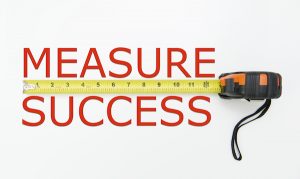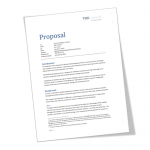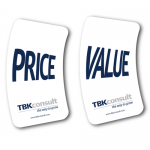How to Deliver Winning Proposals – Part 7
The saying that we can only manage what we can measure is not quite true. There are many areas that we have to manage where we cannot easily measure; at least not in a quantitive way. Leadership and people management are good examples of areas where we often have to go by gut feeling.
However, when it comes to winning proposals we should definitely stay clear of projects where we cannot agree with the client on how to measure the outcome. In this post, which is the seventh in the series “How to Deliver Winning Proposals”, we will discuss how we can define the metrics that we and the client use to determine progress and value.
The proposal is the very last stage of the management consulting sales process. It is the confirmation of what we have already agreed during our discussions with the client. If you make the proposal too early in the sales process then the probability of loosing the business will increase substantially. There should be nothing in the proposal that comes as a surprise to the client.
Prelude
A potential client called me some time ago and asked if I could help them facilitate a strategy process. The company was a full service business and to support their services they had developed a proprietary IT platform. They were considering if they should make the IT platform available to other service providers and maybe turn the IT platform into a business on its own. They were looking for a management consultant that could help them with the strategy process.
 After having asked a few questions it turned out that they were experiencing increased competition from services providers that used 3rd party IT platforms. These IT platforms became increasingly more powerful as the customer base grew rapidly due to the multiplication through many service providers in many countries.
After having asked a few questions it turned out that they were experiencing increased competition from services providers that used 3rd party IT platforms. These IT platforms became increasingly more powerful as the customer base grew rapidly due to the multiplication through many service providers in many countries.
I asked what they wanted me to do and it turned out that they wanted me to participate in a board of directors meeting. I would be given one hour to talk about general considerations around their situation and what I – based on my experience – would recommend them to do. Then there would be a 30-60 minutes Q&A session.
I then asked if they wanted me to prepare specifically for their business case or just outline generic considerations turning a service business into a product business. The client was interested in a dedicated presentation.
I asked what his budget was.
There was no dedicated budget, but I could send them a proposal.
I replied that the job couldn’t be done without a budget and that I needed to know how much they were prepared to invest in having me at the meeting.
He asked what I would charge for doing the job. I asked him how much he considered it worth. We danced around like this for a while until I asked him to send me a proposal and I would consider if I could do the job for what he was prepared to pay.
The Metrics
A metric is an observable, detectable indicator of progress or final success (Source: Alan Weiss “Million Dollar Consulting Proposals“, page 7 ).
We need metrics for two reasons:
- They force us to set SMART objectives and not just grand (and fluffy) statements.
- They ensure that we and our clients agree on how we measure progress and results.
Working with the client defining the metrics is very often a “learning experience” in itself. You will be surprised how many companies are undertaking business development activities with no feed-back system for measuring progress.
I get called in to help companies that have been working on a certain issue for years without any success. You can ask why they call me (or someone else) so late in the day? It is the “boiling frog” phenomenon. If you have an inadequate measuring and feed-back system then you will react very late (sometimes too late).
Without metrics we are wandering half blind in the jungle. By pushing the client to define and agree on the metrics for measuring the performance of our consulting project we are half way to success.
The example in the prelude clearly shows that objectives, metrics and value are closely related.
What is the objective of showing up at a BoD meeting? What is the value? How do you measure the outcome?
I stopped quoting prices for one-off gigs a long time ago. I ask what the client is prepared to pay. If it is below my threshold I’ll say no thanks. If it is above my threshold I may accept (depending on my schedule).
There are engagements where there is no way to arrive at a value based price. The value is what the client is prepared to pay. The only option left to the consultant is to ask how much is on the table.
Types of metrics
Outcomes such as revenue, cost reductions, gross margin, reduced sales cycles, higher productivity and profit are obviously easy to measure. However, these types of outcomes only materialize after the client has implemented the changes that we have recommended. As consultants we may be long gone by then. The client may also choose not to implement the recommendations, or unforeseen circumstances in the environment may impact on the results, positively or negatively.
So we need to agree with the client how we measure the outcome of the assignment itself and not of the results that may materialize in the future.
The client in the prelude had defined the objective like this:
Can you help us describe two strategy scenarios:
Scenario 1: We continue with our current business model. How can we grow to meet certain future objectives?
Scenario 2: We productize our IT platform and make it available to other service providers competing with the other IT platform providers? What is the growth potential, what investment and changes must we make, what are the critical success factors and how do we mitigate the risks?
The outcome will be two growth scenarios with business model definitions, business model environment analysis, critical success factors and risk mitigation strategies.
The metrics will be the BoD agreeing that these two scenarios are realistic and can be executed with the changes, investments and risk outlined.
Other posts in this series
How to Deliver Winning Proposals – Part 1
How to Deliver Winning Proposals – Part 2
How to Deliver Winning Proposals – Part 3
How to Deliver Winning Proposals – Part 4
How to Deliver Winning Proposals – Part 5
How to Deliver Winning Proposals – Part 6
How to Deliver Winning Proposals – Part 8
How to Deliver Winning Proposals – Part 9
How to Deliver Winning Proposals – Part 10
How to Deliver Winning Proposals – Part 11
How to Deliver Winning Proposals – Part 12









